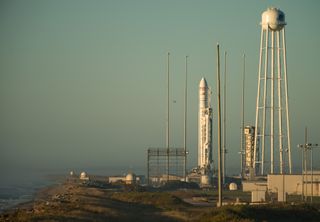Orbital ATK Delays Antares Rocket Launch 24 Hours Due to Glitch

WALLOPS ISLAND, Va. — The long-awaited launch of an Orbital ATK Antares rocket carrying cargo to the International Space Station today has been delayed until Monday, a 24-hour slip, due to a glitch with ground support equipment, NASA officials said Sunday (Oct. 16).
Antares is now scheduled to launch Monday (Oct. 17) at 7:40 p.m. EDT (2340 GMT) from Pad-0A at the Mid-Atlantic Regional Spaceport at NASA's Wallops Flight Facility here.
"Today's launch of Orbital ATK’s Antares rocket is postponed 24 hours due to a ground support equipment (GSE) cable that did not perform as expected during the pre-launch check out," Keith Koehler, a NASA communications officer at Wallops Flight Facility, wrote in a statement. "We have spares on hand, and rework procedures are in process. The Antares and Cygnus teams are not currently working any technical issues with the rocket or the spacecraft." [Viewing Guide: How to See the Nighttime Antares Rocket Launch]
The delay is the latest in a series slips for the Orbital Atk mission, called OA-5, which was initially slated to launch this summer. OA-5 has been a highly anticipated return-to-flight mission for Orbital ATK after the last Antares launch in 2014 ended in an explosion on the launchpad. Monday's launch will carry 5,100 lbs (2,300 kg) of cargo, science equipment and crew supplies to the International Space Station.
Millions of people along the U.S. East Coast and in the Mid-Atlantic states will be able to watch the rocket as it soars into space. Visibility is dependent on local weather conditions, but the nighttime launch window will help make the launch more easily visible against the dark evening sky.
Viewers outside the visible zones can watch the launch in a live webcast at Space.com or tune in to NASA Television. Live coverage will commence around 6:00 p.m. EDT (2200 GMT).
Email Hanneke Weitering at hweitering@space.com or follow her @hannekescience. Follow us @Spacedotcom, Facebook and Google+. Original article on Space.com.
Get the Space.com Newsletter
Breaking space news, the latest updates on rocket launches, skywatching events and more!
Join our Space Forums to keep talking space on the latest missions, night sky and more! And if you have a news tip, correction or comment, let us know at: community@space.com.

Hanneke Weitering is a multimedia journalist in the Pacific Northwest reporting on the future of aviation at FutureFlight.aero and Aviation International News and was previously the Editor for Spaceflight and Astronomy news here at Space.com. As an editor with over 10 years of experience in science journalism she has previously written for Scholastic Classroom Magazines, MedPage Today and The Joint Institute for Computational Sciences at Oak Ridge National Laboratory. After studying physics at the University of Tennessee in her hometown of Knoxville, she earned her graduate degree in Science, Health and Environmental Reporting (SHERP) from New York University. Hanneke joined the Space.com team in 2016 as a staff writer and producer, covering topics including spaceflight and astronomy. She currently lives in Seattle, home of the Space Needle, with her cat and two snakes. In her spare time, Hanneke enjoys exploring the Rocky Mountains, basking in nature and looking for dark skies to gaze at the cosmos.
